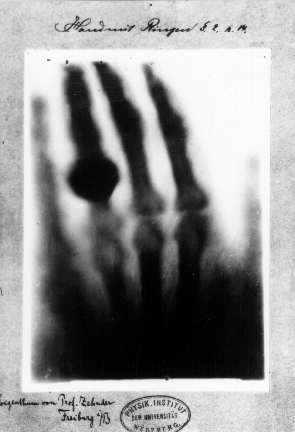 |
| History of Science |
Unfortunately, in many school textbooks the history of science is pushed to the background with oftentimes only the name of the discoverer given and the year they made the discovery 'Wilhelm Röntgen discovered X-Rays in November 1895. The end. Now here is the theory.' There is little context given to the story behind the discovery. At least putting the story behind the discovery as an appendix in a textbook would be great for students to read in their own time. I believe that it is in the knowledge of such stories that a real appreciation of science develops and an understanding that science is not a body of foregone conclusions. Deeper understanding is also possible in learning about the history of science, as students can see misconceptions that scientists previously had in relation to certain phenomena and how such misconceptions were overcome.
So what else is there to know about Röntgen? Röntgen is commonly portrayed as discovering X-Rays by accident, when he noticed cathode rays (streams of electrons from a vacuum tube) caused fluorescence on a nearby small cardboard screen painted with barium plantinocyanide. He was colourblind so he actually noticed more of a flickering on the screen. However, Röntgen had strong investigative skills and he would most likely have discovered X-Rays either way, as he had planned to use the same screen in a following stage of his investigation. He was in fact such an 'investigator' that he had to prove to himself beyond all doubt that what he was observing was not an hallucination. It was not surprising that he thought he was going a bit mad as he was able to see through different things: he could see a key in a book, see through wooden boxes, and even see the bones in his hand. He did not jump to tell people about his discovery, but instead spent a number of weeks in his laboratory meticulously investigating the phenomena further. He wanted to ensure that he had objective results.
 |
| X-Ray of Bertha's hand |
One of the more well-known things about Röntgen is that he did an X-Ray of his wife's hand. She saw it as an omen for death and refused to go back into his lab again. Other physicists were very skeptical about his discovery at first, but he had done such a thorough investigation that he was able to answer to any objection, highlighting the strength of his investigations and the importance of such objective results to the scientific pursuit. Some other interesting aspects about Röntgen was that he was very modest and benevolent. He wanted the rays he had discovered to be called X-Rays and not Röntgen rays. He donated all the prize money from winning the Nobel Prize for Physics in 1901 to his university and he refused to take patents out on his discovery so that it could benefit mankind. Unfortunately, he later became bankrupt after World War I. In 2004, element number 111, formerly called unununium, was re-named roentgenium in his honour.
Further Reading:
-Gribbin, J. (2002) Science: A History. Penguin Books Ltd, London.
-Kean, S (2011). The Disappearing Spoon and Other True Tales from the Periodic Table. Transworld Publishers, London.
Images retrieved from Understanding Society and Wikipedia.
